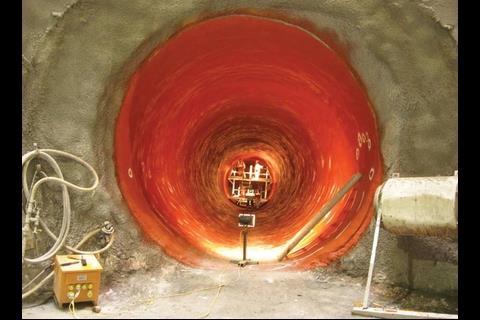Civil engineering may not be the most glamorous profession but the ICE’s London awards give its brightest and best their moment in the limelight. Thomas Lane takes a look at the winners
Only when things go wrong do people really notice the contribution civil engineering makes to the comfort of their daily lives. Thankfully, failures are extremely rare, and so engineering projects remain largely invisible to most people. To give them the recognition they deserve the Institution of Civil Engineers has created the London Civil Engineering Awards. The winners were announced on Wednesday at a ceremony held at the London Transport Museum.
These awards recognise and reward projects in the London area with a substantial civil engineering element – all of them projects that should greatly improve our quality of life. The awards include one for infrastructure, one aimed at buildings, an award for the greatest contribution to London and two special awards.
Infrastructure award
King’s Cross St Pancras Underground Redevelopment / King’s Cross Northern Ticket Hall, phase two
Entered by Arup and Balfour Beatty Infrastructure
Engineer Arup
Client Department of Transport/London Underground
Contractor Atkins Balfour Beatty Management/Balfour Beatty Civil Engineering/Morgan BeMo JV/Balfour Beatty Engineering Services
Architect Allies and Morrison
The King’s Cross northern ticket hall is the last major phase in the revitalisation of King’s Cross and St Pancras stations. Passenger numbers are set to double because of Eurostar, high-speed commuter services and the Olympics in 2012. So the capacity of the Northern, Victoria and Piccadilly lines have been increased by providing a second exit at platform level and tunnels and escalators linking a new ticket hall at the northern end of King’s Cross station.
Building the station and link tunnels under two listed buildings has been a significant engineering challenge. The ticket hall is a four-storey underground structure built using top-down construction methods to minimise ground movement and damage to the adjacent buildings. Compensation grouting was used to maintain earth pressures for the tunnelling, which were excavated using a technique pioneered at Heathrow Terminal 5. A laser linked to a computer controlled the excavator and concrete lining machine, ensuring the tunnels are completely circular.

The Shard construction methodology
Building award
The Shard construction methodology
Entered by Robert Bird Group
Construction engineer Robert Bird Group/Byrne Brothers
Contractor Mace Group
A change from construction management to a fixed-price contract delayed this project, which meant it was imperative to get the programme back on track. Top-down construction had been planned from the start to save time so the challenge was to find a way to shave even more off the programme. Specialist engineering designer Robert Bird Group collaborated with concrete specialist Byrne Brothers and main contractor Mace to come up with an innovative construction method that will reduce construction time by three months.
The solution involved “jump starting” the core. Instead of waiting until the substructure was finished, it has been started at ground level while the basement was being scooped out below. The technique means that the core and steel superstructure can steam ahead while the core continues being built downwards into the basement.
The technique involved sinking plunge piles to support the core, and reinforced concrete will be added to provide permanent support. The team had to ensure the weight of the core wouldn’t cause the steel plunge piles to buckle as it progressed skywards and before the final concrete was placed.
The judges described the technique as a “great collaboration between specialist and main contractors and a logistical and engineering solution that equals Renzo Piano’s iconic vision for the tower itself”.

London 2012 Olympic Park Enabling Projects
Greatest contribution to London
London 2012 Olympic Park Enabling Projects
Entered by Olympic Delivery Authority
Engineer CLM/Atkins
Client Olympic Delivery Authority
Contractor Morrisons Construction/Bam
Architect: Nuttall
The greatest legacy of the Olympics will be the transformation of 2.5km2 of contaminated land into a beautiful new park. Because these works will help kickstart huge swaths of east London, the judges felt it was a worthy winner of the greatest contribution to London award.
The scale of this task was huge. It has involved the demolition of 215 buildings and the excavation of 2.3 million tonnes of soil. This has been cleaned and reused on site or recycled into aggregates. Rivers and canals – 3km of them – have been dredged and hundreds of shopping trolleys and an old car were removed.
Equally impressive is the dedication of the project team tackling the Olympic park enabling works, who cajoled reluctant specifiers into reusing materials reclaimed from the site. This contributed to an impressive 90% recycling rate for demolition waste and 80% of all site-derived materials. This team has also been responsible for delivering 25 bridges. The scale of the achievement and the collaborative approach impressed the judges who said: “The adoption of a co-ordinated park-wide approach is a victory for collaboration.”

Woolwich Town Centre
Special award
Woolwich Town Centre
Entered by Transport for London
Engineer Transport for London
Client London Borough of Greenwich
Contractor Ringway Infrastructure Services/JB Riney
Architect Witherford Watson Mann
Repaving the centre of Woolwich doesn’t sound that exciting but the reality is that these works have transformed the centre of this rundown outpost of south-east London – a result that is out of all proportion to its £6m cost. The first part of the job was completed in 2008 and involved calming traffic on the busy A206 dual carriageway next to the town centre.
The just completed second phase improved the public realm by getting rid of a scruffy area of bare earth and scrubby trees and paving this over to create an extra 500m2 of usable public space. More than 100 trees have been planted and high-quality granite slabs have been used for the pavement areas. EcoPave blockwork was used for the speed tables that calm traffic entering the town centre.
Other work included creating an integrated transport interchange that connects buses, taxis and the Docklands Light Railway. The judges were particularly impressed by the quality of the scheme and the enthusiasm of the project team. “This project is typical of the best of much of the everyday work of engineers that is in general uncelebrated and taken for granted,” said one judge. “It was evident that despite the economic downturn a vibrancy had returned to the town and that the project, together with the DLR link, had become a catalyst for further inward investment and regeneration.”

Innovative tunnelling techniques were used for the Thames Water ring main extension. Cast concrete segments with watertight seals cut six months off the programme
Special award
Thames Water Ring Main Extension
Entered by Mott MacDonald
Engineer Mott MacDonald
Client Thames Water
Contractor Morgan Est/Costain/Black & Veatch
Deep beneath the feet of Londoners is a network of tunnels almost big enough to drive a tube train through. This “ring main” of tunnels circles the capital and carries the bulk of the city’s water from four water treatment works on the western side of the capital. This system makes sure people always have enough clean water to drink, whatever the circumstances.
An expanding population coupled with increasingly unreliable surface water mains prompted Thames Water to extend the network to make it even more resilient. The first element of the job involved connecting an existing reservoir at Honor Oak Park to the ring main at Brixton using a new 2.9m diameter, 4.8km long tunnel. The other element connects an existing tunnel supplied by a water treatment plant in north-east London from Stoke Newington to New River Head via a second 4.5km tunnel. These two measures increase the capacity of the system from 1,100 million litres of water a day to 1,600 million litres. Two large pumping shafts have also been constructed to lift water to the surface. Tunnel-boring machines were used to create both tunnels. The geology of south London is a particular challenge for such work, consisting as it does of a mix of fault lines, clay and hard-to-bore chalk at depths of up to 60m.
The NEC form of contract used on the south London section meant losses or gains would be shared with the client, Thames Water, so the construction team was incentivised to try out innovative techniques to save time and money. The launch tunnel for the tunnel-boring machine at Brixton was lined with sprayed concrete followed by a waterproof membrane. The main tunnel was lined with precast concrete segments complete with rubber gaskets between each section, which removed the need for secondary waterproofing. This saved six months on the three-year programme.
Another benefit is that the water supply to Honor Oak Park is now fed by gravity rather than energy-hungry pumps. The judges said: “So it is for their consequence, their profundity, and their human benefit, as much as for their innovative civil engineering, that the ring main extensions have been chosen. The water supply will be even better, giving greater certainty, greater resilience, using less energy, and extending both its usefulness and its sustainability.”
The shortlist in full
- The Audi centre, Brentford, entered by Expedition Engineering
- 201 Bishopsgate and the Broadgate Tower, entered by Skidmore, Owings & Merrill
- Denewood Road, Highgate, entered by Expedition
- King’s Cross St Pancras Underground station redevelopment and King’s Cross northern ticket hall
- Kings Yard primary electricity substation, Olympic park, entered by EDF Energy
- Olympic park enabling projects
- London School of Hygiene & Tropical Medicine south courtyard infill, Bloomsbury, entered by Sinclair Knight Merz
- The Shard, London Bridge
- Stadthaus, Shoreditch, entered by Techniker
- Thames Water ring main extension, Peckham Rye / Honor Oak Park
- Three Mills Lock and Water Control Structures, Stratford, entered by Tony Gee and Partners
- West Ham strategic flood alleviation scheme, entered by Thames Water and Aecom
- Woolwich town centre
The judges
- Mark Whitby, chair, former chairman of Ramboll Whitbybird
- Ken Dalton, chief executive, Europe, Aecom
- Chris Wise, director of Expedition Engineering
- Susan Angoy, board member, London Development Agency
- Thomas Lane, assistant editor (technical), Building
Original print headline: Civil stars






























No comments yet